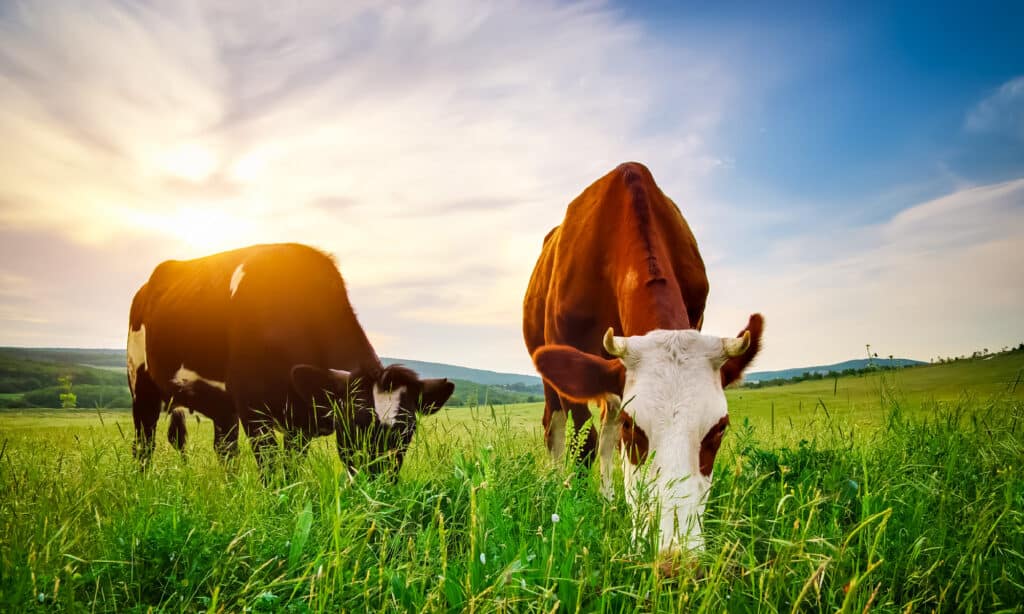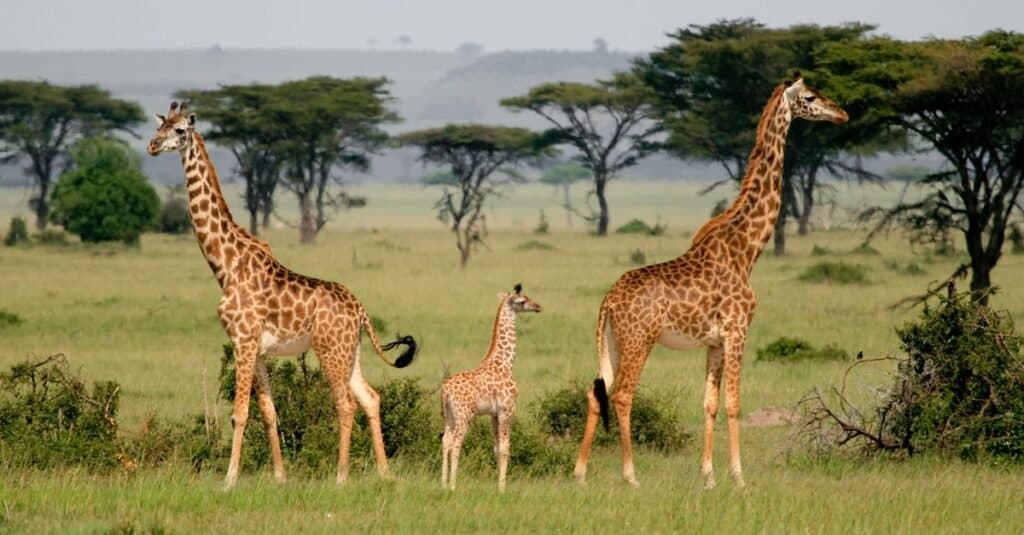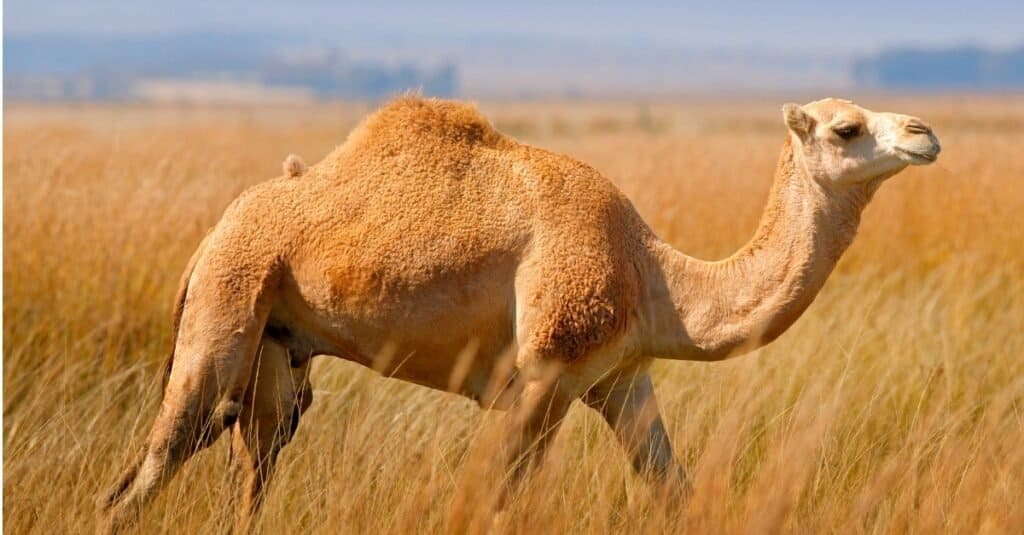Have you ever wondered why some animals chew as if they never run out of food? Well, the truth is, those animals chew cud. People living on the farm know what it means and why some animals do this. If you are curious about what animals chew their cud and why they do this, read this article and discover why!

What Is Cud?
Upon ingestion, the food gets into the first stomach chamber called the rumen, where it is partially digested. The food that requires further digestion is called cud. Therefore, the animals regurgitate the cud to chew it again. They mix the cud with saliva and break it into smaller particles, thus facilitating nutrient absorption. This process is called rumination.
What Animals Chew Cud?
1. Cows

Cows produce saliva as they chew their cud.
©iStock.com/Toltek
The cow is one animal that you will most frequently observe chewing its cud. These creatures are domesticated and raised for beef or milk. Cows primarily eat grass.
Cows produce saliva as they chew their cud. Saliva has natural antacids that balance the rumen’s pH, thus facilitating digestion and allowing cows to eat more and produce more milk.
2. Goats

Goats may ruminate for several hours when eating long hay.
©iStock.com/aurorat
The Capra hircus, the domestic goat species, is raised for its milk, meat, and coat. Goats may ruminate for 35 to 40 percent each day (cud-chewing). The diet affects how much time is spent ruminating. When goats consume grain or finely milled diets, they ruminate very little. However, goats may ruminate for several hours when eating long hay. Like llamas, goats can chew continuously.
3. Sheep

The sheep’s food passes through its four stomach chambers.
©iStock.com/idal
The sheep is another domesticated animal that chews its cud. Farmers raise sheep in herds and breed them for their meat or wool. Although sheep herds often have a dominant ram (male), farmers keep the ewes (females) and ram apart until breeding season.
The sheep’s food passes through its four stomach chambers. Millions of bacteria and digestive fluids begin breaking down the food in the rumen. Lots of gas is produced during this process, including methane, which sheep expel through burping. An hour later, the muscles push the partially digested food back to the mouth so it can be chewed again.
4. Giraffes

The giraffe gets as many nutrients as possible from the fruits and leaves it consumes by chewing cud.
©iStock.com/bzamora
With its extraordinarily long neck, the dignified giraffe is unique. It might seem impossible that giraffes regurgitate food, but that’s the truth! Giraffes are browsers that primarily consume tree leaves. With their long necks, they naturally eat from the tops of tall trees.
The giraffe gets as many nutrients as possible from the fruits and leaves it consumes by chewing cud. Its upper lip and 18-inch-long tongue are prehensile, allowing them to hold onto branches and leaves and prevent injuries while eating acacia leaves.
5. Camels

The camel’s digestive system is different from that of other ruminants.
©Ondrej Prosicky/Shutterstock.com
Camels are not true ruminants because they don’t have the same gut anatomy as cows and other ruminant animals, but they also chew their cud. The camel’s digestive system is different from that of other ruminants. The Bactrian camel stomach only has three chambers without an omasum. Also, compared to other large herbivores, camels keep feed particles in their stomachs longer.
Most of the camel’s natural habitat is the desert, but it also includes other places with few or no plants. They chew the cud to extract as many nutrients as possible from their meal.
Are Animals That Chew Cud Ruminants?
Ruminants are referred to as animals that chew their cud. But some animals that chew cud are not considered true ruminants, like the camel. As mentioned above, a camel is considered not a true ruminant because it only has three stomachs, unlike true ruminants, which have four stomachs. Ruminants are herbivores, which means that plants make up most of their diet. Because their stomachs have four chambers, they can store and uniquely digest their food.
The Four Stomach Chambers of Ruminants
The Rumen
The largest stomach section and collection of sacs is the rumen, which is located on the animal’s left side. It can carry around 25 gallons of plant and liquid material, depending on the animal’s size. Since it’s the largest, the rumen is a storage or holding basin for feed.
In addition to its storage properties, the rumen serves as a vessel for fermentation. The microbes that thrive in the rumen are responsible for digesting and fermenting the feed, as well as producing volatile fatty acids (VFAs). Most of the VFAs produced by fermentation are absorbed in the rumen.
VFAs and other digestion products are better absorbed when there is a good flow of blood to the walls of the rumen. The rumen is lined with tiny protrusions called papillae, which expand the rumen’s surface area and capacity for absorption.
The Reticulum
The reticulum is a structure that looks like a pouch and is located near the heart. The reticulum’s tissues group together to create a honeycomb-like network. Despite the fact that they are not independent organs, the rumen and reticulum are separated by a tiny tissue fold. They are collectively known as the rumino-reticulum.
Metal objects and heavy or dense grain that the cow eats fall into this compartment. The tissue may be damaged by nails and other sharp objects, leading to “hardware disease.” You can treat or prevent the disease with magnets or resort to surgery to fix the problem. Ignoring it could result in infection and even death.
The Omasum
The globe-shaped structure called the omasum contains leaves of tissue resembling book pages. It takes on things from the digestive tract, including water. The ingesta (feed material) between the leaves is going to be drier than the ingesta in the other compartments.
The Abomasum
Only the abomasum has a gland-lined chamber. To break down meals, these glands emit hydrochloric acid and digestive enzymes. The abomasum resembles the stomach of a non-ruminant animal.
Why Is Chewing Cud Vital to Ruminants?

Chewing cud is essential for the health and production of the herd as a whole.
©Jonathan_Densford/Shutterstock.com
In the end, chewing cud is essential for the health and production of the herd as a whole.
High-quality grass, hay, silage, and concentrates help keep the ruminants’ digestive tracts in good shape. The digestion process starts with chewing their food. As soon as it enters the rumen, the biggest chamber, the microbes, including bacteria, decompose and ferment food.
These microbes help ruminants to digest tough carbohydrates like cellulose found in plants and convert feed to energy. But microbes cannot do it alone. Food needs to be regurgitated for rechewing for microbes to digest cellulose and fibers so it will be small enough to be absorbed in the bloodstream.
Also, rumen walls have tiny projections like fingers that improve the surface area for absorbing nutrients. If the ruminants fail to regurgitate, the nutrients will not be properly absorbed. Thus, causing illnesses and other health issues for ruminants.
Summary of 5 Animals That Chew Cud
| Number | Animal | Cud Chewing Process |
|---|---|---|
| 1 | Cows | Produces saliva, which has natural antacids that balance the rumen’s pH, facilitating digestion and allowing cows to eat more and produce more milk |
| 2 | Goats | May ruminate for 35-40% each day; diet affects how much time is spent ruminating |
| 3 | Sheep | Food passes through its four stomach chambers, then bacteria and digestive fluids begin breaking down food |
| 4 | Giraffes | Gets as many nutrients as possible from fruits and leaves it consumes by chewing cud |
| 5 | Camels | Not true ruminants but also chew cud; Bactrian camel stomachs only have three chambers without an omasum |
The photo featured at the top of this post is © Jane_Stanley/Shutterstock.com
Thank you for reading! Have some feedback for us? Contact the AZ Animals editorial team.






